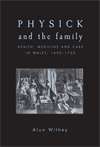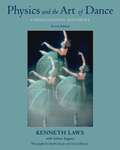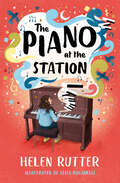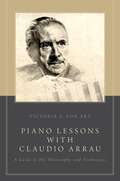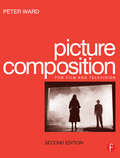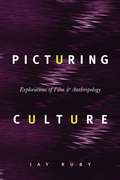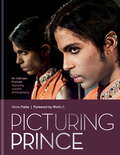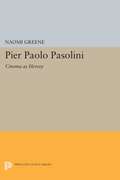- Table View
- List View
Physical Theatres: A Critical Introduction
by Simon Murray John KeefeThis new edition of Physical Theatres: A Critical Introduction continues to provide an unparalleled overview of non-text-based theatre, from experimental dance to traditional mime. It synthesizes the history, theory and practice of physical theatres for students and performers in what is both a core area of study and a dynamic and innovative aspect of theatrical practice. This comprehensive book: traces the roots of physical performance in classical and popular theatrical traditions looks at the Dance Theatre of DV8, Pina Bausch, Liz Aggiss and Jérôme Bel examines the contemporary practice of companies such as Théatre du Soleil, Complicite and Goat Island focuses on principles and practices in actor training, with reference to figures such as Jacques Lecoq, Lev Dodin, Philippe Gaulier, Monika Pagneux, Etienne Decroux, Anne Bogart and Joan Littlewood. Extensive cross references ensure that Physical Theatres: A Critical Introduction can be used as a standalone text or together with its companion volume, Physical Theatres: A Critical Reader, to provide an invaluable introduction to the physical in theatre and performance. New to this edition: a chapter on The Body and Technology, exploring the impact of digital technologies on the portrayal, perception and reading of the theatre body, spanning from onstage technology to virtual realities and motion capture; additional profiles of Jerzy Grotowski, Wrights and Sites, Punchdrunk and Mike Pearson; focus on circus and aerial performance, new training practices, immersive and site-specific theatres, and the latest developments in neuroscience, especially as these impact on the place and role of the spectator.
Physick and the family: Health, medicine and care in Wales, 1600–1750 (PDF)
by Alun WitheyPhysick and the family offers new insights into the early modern sickness experience, through a study of the medical history of Wales. This first ever monograph of early modern Welsh medicine utilises a large body of newly discovered source material, numerous approaches and methodologies and makes a significant contribution to debates in medical history; including economies of knowledge, domestic medicine and care, material culture and the rural medical marketplace. Drawing on sources from probates to parish records, diaries to domestic remedy collections, Withey offers new directions for recovering the often obscure medical worldview of the ‘ordinary’ person. This innovative study will appeal to anyone interested in the social history of the early modern period. Its multi-disciplinary approach will appeal to a broad spectrum of academics and scholars, and will enhance a range of courses and modules both in medical history and in social history more widely.
Physick and the family: Health, medicine and care in Wales, 1600–1750 (G - Reference,information And Interdisciplinary Subjects Ser.)
by Alun WitheyPhysick and the family offers new insights into the early modern sickness experience, through a study of the medical history of Wales. Newly available in paperback, this first ever monograph of early modern Welsh medicine utilises a large body of newly discovered source material. Using numerous approaches and methodologies, it makes a significant contribution to debates in medical history, including economies of knowledge, domestic medicine and care, material culture and the rural medical marketplace. Drawing on sources from probates to parish records, diaries to domestic remedy collections, Withey offers new directions for recovering the often obscure medical worldview of the ‘ordinary’ person. This innovative study will appeal to anyone interested in the social history of the early modern period. Its multi-disciplinary approach will appeal to a broad spectrum of academics and scholars, and will enhance a range of courses and modules both in medical history and in social history more widely.
Physics And The Art Of Dance: Understanding Movement
by Kenneth Laws Arleen SuganoWritten by a physicist with professional dance training, Physics and the Art of Dance explains how dancers can achieve better, safer performances through an understanding of physics in motion. Using simple, non-technical terms, Kenneth Laws combines his knowledge of both physics and dance todescribe how the laws of gravity, momentum, and energy affect dancing bodies. The book explores the natural laws that govern the subtleties of balance, the techniques of leaps and pirouettes, and the impressive lifts and turns executed by ballet partners. Finally, Laws offers insight into twocurrent discussions in the dance world--the effect of body size on ballet technique, and the relationship between science and the art of dance. Beautiful, original stop-action photographs by Martha Swope, along with clear diagrams, illustrate the concepts described in the text. Plus, an intriguing "puzzler" at the beginning of each chapter provides an engaging entree into the topics presented. For those who want a more advancedunderstanding of the physics, extensive appendices are provided. This new book combines the best features of Laws's widely acclaimed The Physics of Dance and Physics, Dance, and the Pas de Deux by Laws and Cynthia Harvey. Its expert application of the basic principles of physics to the art of dance will be an invaluable resource for dancers and dance instructorsand will open a new level of appreciation for lovers of the form. It will also appeal to physicists who seek to include the arts in their scientific pursuits.
Physics and Dance
by Emily Coates Sarah DemersA fascinating exploration of our reality through the eyes of a physicist and a dancer—and an engaging introduction to both disciplines From stepping out of our beds each morning to admiring the stars at night, we live in a world of motion, energy, space, and time. How do we understand the phenomena that shape our experience? How do we make sense of our physical realities? Two guides—a former member of New York City Ballet, Emily Coates, and a CERN particle physicist, Sarah Demers—show us how their respective disciplines can help us to understand both the quotidian and the deepest questions about the universe. Requiring no previous knowledge of dance or physics, this introduction covers the fundamentals while revealing how a dialogue between art and science can enrich our appreciation of both. Readers will come away with a broad cultural knowledge of Newtonian to quantum mechanics and classical to contemporary dance. Including problem sets and choreographic exercises to solidify understanding, this book will be of interest to anyone curious about physics or dance.
The Piano at the Station
by Helen RutterWhen Lacey gets sent to lunch-time music lessons to keep her out of trouble at school, she discovers a love and talent for the piano that opens up a whole new world. But when Lacey's music teacher leaves unexpectedly, will she be thrown back into turmoil?
Piano Lessons with Claudio Arrau: A Guide to His Philosophy and Techniques
by Victoria A. von ArxPiano Lessons with Claudio Arrau provides an insider's view of the art of piano performance as exemplified by one of the great artists of the twentieth century. Chilean pianist Claudio Arrau devoted his life to the piano and its music. As a child prodigy, he gained national recognition from government officials in Chile, including President Pedro Montt, who funded Arrau's education in Germany. Arrau studied in Berlin with Martin Krause, a pupil of Franz Liszt, and later immigrated to New York City where he taught and mentored a sizeable group of pupils while at the same time managing an international performing career. Arrau's profound musical insight and unique style of teaching inspired his pupils and motivated them to teach his principles to the next generation of students. This in-depth study of Arrau's principles and philosophy of technique and performance draws on information from published interviews with Arrau, from numerous interviews with Arrau's pupils, and from the author's experience in studying piano with two of them. Transcripts of actual lessons given by Arrau and preserved on tape present in his own words a detailed account of his technical and interpretive ideas about five major works of the piano repertory. References to over one hundred examples from Arrau's filmed recordings enable readers to observe the elements of Arrau's famed technique in action.
Piano Lessons with Claudio Arrau: A Guide to His Philosophy and Techniques
by Victoria A. von ArxPiano Lessons with Claudio Arrau provides an insider's view of the art of piano performance as exemplified by one of the great artists of the twentieth century. Chilean pianist Claudio Arrau devoted his life to the piano and its music. As a child prodigy, he gained national recognition from government officials in Chile, including President Pedro Montt, who funded Arrau's education in Germany. Arrau studied in Berlin with Martin Krause, a pupil of Franz Liszt, and later immigrated to New York City where he taught and mentored a sizeable group of pupils while at the same time managing an international performing career. Arrau's profound musical insight and unique style of teaching inspired his pupils and motivated them to teach his principles to the next generation of students. This in-depth study of Arrau's principles and philosophy of technique and performance draws on information from published interviews with Arrau, from numerous interviews with Arrau's pupils, and from the author's experience in studying piano with two of them. Transcripts of actual lessons given by Arrau and preserved on tape present in his own words a detailed account of his technical and interpretive ideas about five major works of the piano repertory. References to over one hundred examples from Arrau's filmed recordings enable readers to observe the elements of Arrau's famed technique in action.
Picasso: My Grandfather
by Marina PicassoMarina Picasso remembers being six years old and standing awkwardly in front of the gates of Picasso's grand house near Cannes. She was there with her father and eight-year-old brother to collect from her grandfather the weekly allowance that Picasso grudgingly gave his eldest son to support is family. Sometimes they were sent away and on other occasions, the gates would be opened and they would walk into the intimidating, exciting chaos of Picasso's studio to face the man himself and his unpredictable moods. Looking back, Marina can understand why Picasso had so little interest in his grandchildren; but at the time, she and her brother longed for him to love and understand them. Just a few miles away down the Côte d'Azur, they led a hand-to-mouth existence. Her father was a weak man, reliant on his father for everything and her mother lived in her own fantasy world; the family were therefore utterly dependent on Picasso. People assumed they were rich and privileged because they were Picassos and they were to live their lives under the burden of these assumptions. It was this that caused Marina's brother to commit suicide and when her father died Marina found herself in the ironic position of being one of the major heirs to Picasso's estate.
Piccadilly: The Circus at the Heart of London
by Midge GilliesThere's nowhere quite like Piccadilly Circus.From the moment they emerge, blinking from the underground station, visitors to Piccadilly Circus face a sensory onslaught. Its streets and alleyways merge into an intoxicating thoroughfare, with the power to propel an individual onwards to adventure, romance, or something more sinister. Ever since its iconic Eros statue appeared in 1893, the junction has been a vibrant meeting place, attracting visitors and pleasure-seekers from all walks of life: political plans and theatrical careers were hatched at its restaurant and café tables, lovers met below the statue of Eros, and to this day tourists pour out of its historic Tube to experience the bright lights of London's nightlife.Piccadilly explores how the area has been shaped by social and historical events - from female suffrage to world wars to technological advancements - and by its colourful cast of characters - from flower girls, shop assistants and sex workers, to film stars, Bright Young Things and conmen (and women).For many, the Circus has represented both a home from home and a brave new world, as campaigners, revellers, opportunists and romantics have all been drawn to Piccadilly's bright lights. This is the story of why Piccadilly Circus continues to mean so much to so many.
Pick N Mix (Modern Plays)
by Kat Rose-MartinThe 354 Johnnyarm from Vagland will shortly be arriving in Wombtown, please brace for impact.Three lasses. One lad. And a bucket load of teen angst.When Olivia, Kim and Alisha all take a fancy to the same local lad, friendships and families are torn apart. Lies are told, secrets are spilled and their lives are about to change forever. Pick N Mix is a coming-of-age story of sisterhood, Sex Ed and sanitary pads.Kat Rose-Martin is a Bradford lass born and bred. She was the first winner of Kay Mellor Fellowship, and has written for stage and TV, including BBC's Holby City & Sky's Wolfe. Pick N Mix is her first full-length play.This edition was published to coincide with the UK tour in Leeds and Bradford, in November 2022.
Pick N Mix (Modern Plays)
by Kat Rose-MartinThe 354 Johnnyarm from Vagland will shortly be arriving in Wombtown, please brace for impact.Three lasses. One lad. And a bucket load of teen angst.When Olivia, Kim and Alisha all take a fancy to the same local lad, friendships and families are torn apart. Lies are told, secrets are spilled and their lives are about to change forever. Pick N Mix is a coming-of-age story of sisterhood, Sex Ed and sanitary pads.Kat Rose-Martin is a Bradford lass born and bred. She was the first winner of Kay Mellor Fellowship, and has written for stage and TV, including BBC's Holby City & Sky's Wolfe. Pick N Mix is her first full-length play.This edition was published to coincide with the UK tour in Leeds and Bradford, in November 2022.
Picnic at Hanging Rock (BFI Film Classics)
by Anna Backman RogersPeter Weir's haunting and allusive Picnic at Hanging Rock (1975), set in 1900, tells the story of the mysterious disappearance of three schoolgirls and their teacher on a trip to a local geological formation. The film is widely hailed as a classic of new Australian cinema, seen as exemplary of a peculiarly Australian style of heritage filmmaking.Anna Backman Rogers' study considers Picnic from feminist, psychoanalytic and decolonialising perspectives, exploring its setting in a colonised Australian bushland in which the Aboriginal people are a spectral presence in a landscape stolen from them in pursuit of the white man's 'terra nullius'. She delves into the film's production history, addressing director Weir's influences and preoccupations at the time of its making, its reception and its lasting impact on visual culture more broadly. Rogers addresses the film's treatment of the young schoolgirls and their teachers, seemingly, as embodiments of an archetype of the 'eternal feminine', as objects of the male gaze, and in terms of ideas about female hysteria as a protest against gender norms. She argues that Picnic is, in fact, highly subversive: a film that requires its viewers to read its seductive surfaces against the grain of the image in order to uncover its psychological depths.
Picnic at Hanging Rock (BFI Film Classics)
by Anna Backman RogersPeter Weir's haunting and allusive Picnic at Hanging Rock (1975), set in 1900, tells the story of the mysterious disappearance of three schoolgirls and their teacher on a trip to a local geological formation. The film is widely hailed as a classic of new Australian cinema, seen as exemplary of a peculiarly Australian style of heritage filmmaking.Anna Backman Rogers' study considers Picnic from feminist, psychoanalytic and decolonialising perspectives, exploring its setting in a colonised Australian bushland in which the Aboriginal people are a spectral presence in a landscape stolen from them in pursuit of the white man's 'terra nullius'. She delves into the film's production history, addressing director Weir's influences and preoccupations at the time of its making, its reception and its lasting impact on visual culture more broadly. Rogers addresses the film's treatment of the young schoolgirls and their teachers, seemingly, as embodiments of an archetype of the 'eternal feminine', as objects of the male gaze, and in terms of ideas about female hysteria as a protest against gender norms. She argues that Picnic is, in fact, highly subversive: a film that requires its viewers to read its seductive surfaces against the grain of the image in order to uncover its psychological depths.
Picture Composition
by Peter WardBehind each shot there lies an idea or purpose. When setting up a shot, the camera operator can employ a range of visual techniques that will clearly communicate the idea to an audience. Composition is the bedrock of the operator's craft, yet is seldom taught in training courses in the belief that it is an intuitive, personal skill. Peter Ward shows how composition can be learned, to enhance the quality of your work. Based on the author's own practical experience, the book deals with the methods available for resolving practical production questions such as: Does the shot composition accurately reflect the idea that initiated the shot? Will the content and method of presenting the subject accurately convey the idea? Major innovations in television and film production since the previous edition have affected the styles of composition, such as wide-screen and the use of mini DV cameras. These new technologies and their implications for picture composition are addressed in this new edition. A new colour plate section is also being included to update the section on colour. If you are a practising camera operator, trainee camera operator, student or lecturer on a television or film production course, or simply a video enthusiast wishing to progress to a more professional standard you will find this book essential in enhancing the quality of your work.
Picture Composition
by Peter WardBehind each shot there lies an idea or purpose. When setting up a shot, the camera operator can employ a range of visual techniques that will clearly communicate the idea to an audience. Composition is the bedrock of the operator's craft, yet is seldom taught in training courses in the belief that it is an intuitive, personal skill. Peter Ward shows how composition can be learned, to enhance the quality of your work. Based on the author's own practical experience, the book deals with the methods available for resolving practical production questions such as: Does the shot composition accurately reflect the idea that initiated the shot? Will the content and method of presenting the subject accurately convey the idea? Major innovations in television and film production since the previous edition have affected the styles of composition, such as wide-screen and the use of mini DV cameras. These new technologies and their implications for picture composition are addressed in this new edition. A new colour plate section is also being included to update the section on colour. If you are a practising camera operator, trainee camera operator, student or lecturer on a television or film production course, or simply a video enthusiast wishing to progress to a more professional standard you will find this book essential in enhancing the quality of your work.
Picturing Culture: Explorations of Film and Anthropology
by Jay RubyHere, Jay Ruby—a founder of visual anthropology—distills his thirty-year exploration of the relationship of film and anthropology. Spurred by a conviction that the ideal of an anthropological cinema has not even remotely begun to be realized, Ruby argues that ethnographic filmmakers should generate a set of critical standards analogous to those for written ethnographies. Cinematic artistry and the desire to entertain, he argues, can eclipse the original intention, which is to provide an anthropological representation of the subjects. The book begins with analyses of key filmmakers (Robert Flaherty, Robert Garner, and Tim Asch) who have striven to generate profound statements about human behavior on film. Ruby then discusses the idea of research film, Eric Michaels and indigenous media, the ethics of representation, the nature of ethnography, anthropological knowledge, and film and lays the groundwork for a critical approach to the field that borrows selectively from film, communication, media, and cultural studies. Witty and original, yet intensely theoretical, this collection is a major contribution to the field of visual anthropology.
Picturing home: Domestic life and modernity in 1940s British film (Studies in Popular Culture)
by Hollie PricePicturing home examines the depiction of domestic life in British feature films made and released in the 1940s. It explores how pictorial representations of home onscreen in this period re-imagined modes of address that had been used during the interwar years to promote ideas about domestic modernity. Picturing home provides a close analysis of domestic life as constructed in eight films, contextualising them in relation to a broader, offscreen culture surrounding the suburban home, including magazines, advertisements, furniture catalogues and displays at the Daily Mail Ideal Home Exhibition. In doing so, it offers a new reading of British 1940s films, which demonstrates how they trod a delicate path balancing prewar and postwar, traditional and modern, private and public concerns.
Picturing home: Domestic life and modernity in 1940s British film (Studies in Popular Culture)
by Hollie PricePicturing home examines the depiction of domestic life in British feature films made and released in the 1940s. It explores how pictorial representations of home onscreen in this period re-imagined modes of address that had been used during the interwar years to promote ideas about domestic modernity. Picturing home provides a close analysis of domestic life as constructed in eight films, contextualising them in relation to a broader, offscreen culture surrounding the suburban home, including magazines, advertisements, furniture catalogues and displays at the Daily Mail Ideal Home Exhibition. In doing so, it offers a new reading of British 1940s films, which demonstrates how they trod a delicate path balancing prewar and postwar, traditional and modern, private and public concerns.
Picturing Prince: An Intimate Portrait
by Steve ParkePICTURING PRINCE sees the late icon's former art director, STEVE PARKE, revealing stunning intimate photographs of the singer from his time working at Paisley Park. At least half of the images in the book are exclusively published here for the first time; most other images in the book are rare to the public eye.Alongside these remarkable images are fifty engaging, poignant and often funny written vignettes by Parke, which reveal the very human man behind the reclusive superstar: from shooting hoops to renting out movie theatres at 4am; from midnight requests for camels to meaningful conversations that shed light on Prince as a man and artist. STEVE PARKE started working with Prince in 1988, after a mutual friend showed Prince some of Steve's photorealistic paintings. He designed everything from album covers and merchandise to sets for Prince's tours and videos. Somewhere in all of this, he became Paisley Park's official art director. He began photographing Prince at the request of the star himself, and continued to do so for the next several years. The images in this book are the arresting result of this collaboration.
Picturing the Primitive: Visual Culture, Ethnography, and Early German Cinema
by A. OksiloffPrimitive Pictures explores the relationship between early German cinema and anthropology's fascination with 'primitive' cultures. At the core of this study is a mythic first contact between the camera and the non-Western body. The term that binds the two is the 'Primitive', referring both to cultures ostensibly existing outside of modern Time and also to a way of seeing the world via the lens. Asseka Oksiloff examines how the movie camera, with its capacity to record reality in a supposedly direct fashion, is legitimated by the primitive body in the first decades of the twentieth century. From the earliest research footage to popularized adventure footage, the film theory, the 'primitive' holds out the promise of a critical space that affirms modern, technological vision.
Pieces of My Heart: A Life (Playaway Adult Nonfiction Ser.)
by Robert WagnerIn this moving memoir, Robert J. Wagner opens his heart to share the romances, the drama and the humor of an incredible life. Under the mentorship of stars like Spencer Tracy, he became a salaried actor in Hollywood's studio system among other hot actors of the moment such as his friends Rock Hudson and Tony Curtis. Wagner began to appear in a number of films alongside the most beautiful starlets. As his career blossomed he met the woman who would change his life forever, Natalie Wood. They fell instantly and deeply in love and stayed together until the stress of their careers drove them to divorce.Trying to forget the pain, he made more movies and spent his time in Europe with the likes of Steve McQueen, Sophia Loren, Peter Sellers, Laurence Olivier, David Niven, Liz Taylor and Joan Collins. He would meet and marry the beautiful former model and actress Marion Marshall. Together they had a daughter, and made their way back to America, where he found himself at the beginning of a new era in Hollywood - the blossoming of television.Despite his new found success, his marriage to Marion fell apart. He looked no further than Natalie Wood, for whom he still pined. To the world's surprise, they fell in love all over again. Their life together was cut tragically short, though, when Wood died after falling from their yacht. For the first time, Wagner writes about that tremendously painful time. After a serious bout with depression, he finally resurfaced and eventually married Jill St. John, who helped keep his family and his fractured heart together.
Pieces of Vincent
by David WatsonA hopeful young man, a teacher in love, a pregnant woman. A fearful policeman, a boy on a mission, a pianist in the rain. A wounded man, a grandmother. . . and Vincent.Nine lives fractured by the events of one tragic day.'David Watson is a remarkable writer - he writes with searing accuracy and without any shrill moralising.' Sunday Times'A writer of rare human sympathy.' Daily Telegraph
The Pied Piper (Oberon Bks.)
by Robert Browning Adrian MitchellAdrian Mitchell’s triumphant musical adaptation for children of Browning’s The Pied Piper. Premiered at the Royal National Theatre and performed throughout the world.
Pier Paolo Pasolini: Cinema as Heresy
by Naomi GreeneThe major Italian filmmaker Pier Paolo Pasolini was also a poet, novelist, essayist, and iconoclastic political commentator. Naomi Greene reveals to English-speaking readers the diverse talents that made him one of the most controversial European intellectuals of the postwar era, at the center of political and cultural debates still vital to our time. Greene presents Pasolini's films to the English-speaking world in full detail and in a rich critical context, using them to trace the evolution of his ideas and the details of his troubled personal life from 1950, when he settled in Rome, to 1975, the year of his brutal murder, apparently at the hands of a young male prostitute. "In her concise and sympathetic book, Greene intelligently explicates the political and social context within which Pasolini became both a leading figure and a significant heretic. He was an atheist who directed one of the few genuinely profound biblical films in the cinema, a communist who severely criticized many of the radical movements of modern Italy. Though he publicly acknowledged his homosexuality, he privately referred to it as his "sickness." As the book well documents, Pasolini was not a rebel but rather an authentic heretic who worked in contradiction to both his medium and milieu."--ChoiceOriginally published in 1992.The Princeton Legacy Library uses the latest print-on-demand technology to again make available previously out-of-print books from the distinguished backlist of Princeton University Press. These editions preserve the original texts of these important books while presenting them in durable paperback and hardcover editions. The goal of the Princeton Legacy Library is to vastly increase access to the rich scholarly heritage found in the thousands of books published by Princeton University Press since its founding in 1905.

